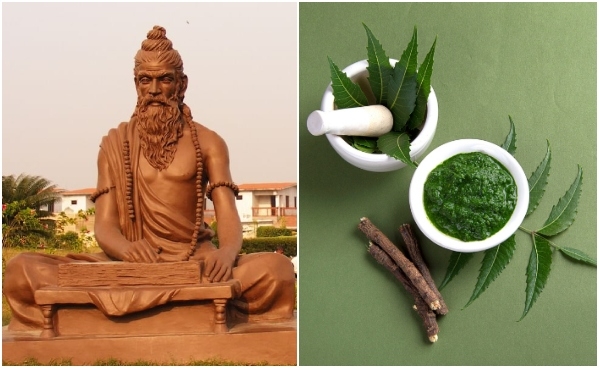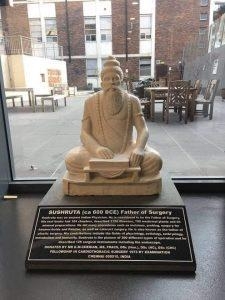Influence of Ayurveda and Plastic Surgery in Arabia and Europe
Total Views |
-Ravi Kumar
Ayurveda is the earliest school of medicine known to humans. Cure for Leprosy is mentioned in Atharva Ved. The much-travelled Greek mathematician Pythagoras is supposed to have visited India and took with him Indian books on mathematics, medicine and the transmigration of the soul. Socrates, Plato and Hippocrates were influenced by Indian thought and believed in rebirth. Alexander's invasion of the Gandhara region led to closer ties between Greece and India. During the period of colonial British rule of India, the practice of Ayurveda was neglected by the British Indian Government, in favor of modern medicine.
Ayurveda is the earliest school of medicine known to humans. Cure for Leprosy is mentioned in Atharva Ved. The much-travelled Greek mathematician Pythagoras is supposed to have visited India and took with him Indian books on mathematics, medicine and the transmigration of the soul. Socrates, Plato and Hippocrates were influenced by Indian thought and believed in rebirth. Alexander's invasion of the Gandhara region led to closer ties between Greece and India. During the period of colonial British rule of India, the practice of Ayurveda was neglected by the British Indian Government, in favor of modern medicine.

Rani Vishpala’s name is mentioned in Rig Veda (RV 1.112.10, 116.15, 117.11, 118.8 and RV 10.39.8) (1200 BCE). Surgery was performed on her amputated leg and an iron leg was fixed. Sushruta is the father of surgery. 2600 years ago, he and health scientists of his time conducted complicated surgeries like cesareans, cataract, artificial limbs, fractures, urinary stones and even plastic surgery and brain surgery. Usage of anesthesia was well known in ancient India. Sushruta's medical prowess is exhibited through his writings on rhinoplasty, involving nasal reconstructions using skin from the patient's forehead or cheek.
Sushruta in Asian Countries
Sushruta’s text Sushrut Samhita was translated to Arabic as ‘Kitab Shah Shun al-Hindi' in Arabic, also known as Kitab i-Susurud, in Baghdad during the early 8th century at the instructions of a member of the Barmakid family of Baghdad. Yahya ibn Barmak facilitated a major effort at collecting and translating Sanskrit texts such as Vagbhata's Astanga-hrdaya Samhita, Ravigupta's Siddhasara and Sushruta Samhita. Barmakids were Sindhi scholars whose forefather Barmak (Pramukh) was taken to Baghdad by Islamic invaders as a slave. Sushrut Samhita was also known to the Khmer king Yasovarman I (r. 889-910) of Cambodia. Susruta was also known as a medical authority in Tibetan literature.
The medical works of ancient Hindu scholars Sushruta and Charaka were translated into the Arabic language during the 8th century. The 9th-century Persian physician Rhazes (854 - 925 CE, and the 10th century scholar Ibn al-Nadim who died in 995 CE, were familiar with Ayurvedic texts. Abbasid Sultan Harun al-Rashid (762 – 809) was cured by Indian physician Manka.
Influence Sushruta’s Plastic Surgery in Europe
The Arabic works on Indian medicine, eventually reached a European audience around 1400 CE. Italian Surgeons Branca de'Branca and his son Antonio Branca in Sicily were influenced by the Arabic reception of the surgical techniques of Sushruta. Branca de'Branca was the first European surgeon, who restored a lost nose by taking flap from the cheek. This "Italian method" was first described in 1460. In Renaissance Italy, the Branca family of Sicily and surgeon Gaspare Tagliacozzi (1545-1599 CE) of Bologna are known to have been influenced by the surgical techniques of Sushruta. Soon after Tagliacozzi's death, plastic surgery fell into disuse.
After Tagliacozzi's death, British physicians travelled to India to see rhinoplasty being performed using native methods. Reports on Indian rhinoplasty performed by a Kumhar (potter) vaidya were published in the Gentleman's Magazine in 1794. This brought the Indian methods again to the attention of European surgeons and initiated the revival of the practice. German surgeons as Carl Ferdinand Graefe, Johann Friedrich Dieffenbach and Bernhard Langenbeck led it to its full modern development.
Instruments described in the Sushruta Samhita were further modified in the Western World. Joseph Constantine Carpue spent 20 years in India studying local plastic surgery methods. In 1815, he was able to perform the first major surgery in the western world, the "Indian" method of nose reconstruction. The Indian rhino plastic reconstruction, using a flap of skin taken from the forehead, became known in Europe as "Carpue's operation". (Hiding the Indian origin. This is another Case of Euro-centrism). In 1816 Carpue described the procedure in his publication of "Account of Two Successful Operations for Restoring a Lost Nose from the Integument of the Forehead".
Influence of Ayurveda in Europe
In the 16th century in Europe, Paracelsus (1493 – 1541 CE Swiss, German), who is known as the father of modern Western medicine, practiced and propagated a system of medicine, which borrowed heavily from Ayurveda.
Garcia de Orta (1501– 1568 CE), a Portuguese Jewish physician, was a pioneer of tropical medicine, working mainly in Goa, then a Portuguese colony in India. His magnum opus, a book on the simple drugs of India (herbs used singly), was published in 1563 as Coloquios dos simples e drogas da India. It is the earliest treatise on the medicinal and economic plants of India. Carolus Clusius translated it into Latin. It was widely used as a standard reference text on medicinal plants.
Jean Filliozat (1906– 1982) was a French author. He studied medicine and was a physician between 1930 and 1947. He learned Sanskrit, Pali, Tibetan and Tamil. He wrote some important works on the history of Indian medicine. He taught at College de France from 1952 to 1978.
Ayurveda in Independent Bharat
After Indian Independence, there has been more focus on Ayurveda and other traditional medical systems. Last nine years have seen a rapid growth in Ayurveda and Siddha medicines and yoga techniques for wellness. Ayurveda is at present well integrated into the Indian National health care system, with state hospitals for Ayurveda established across the country. In last few decades Ayurveda has spread widely around the world.
Today cosmetic surgery has become more popular, and India has become Asia's biggest cosmetic surgery market.
Highlights of the Indian Healthcare System
- The East treats the person; the West treats the disease.
- "Our system (or western system) of medicine is very fragmented," says Dr. Carrie Demers, who runs the Center for Health and Healing at the Himalayan International Institute of Yoga Science and Philosophy of the USA in Honesdale, Pa. “We send you to different specialists to look at different parts of you.”
- “Yoga is more holistic; it's interested in the integration of body, breath and mind."


